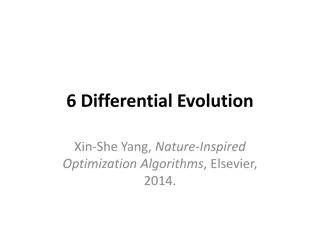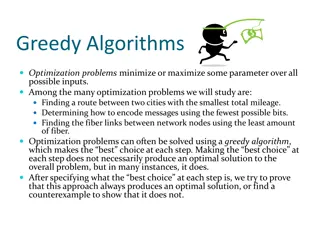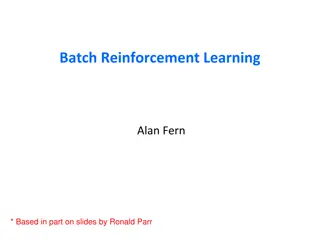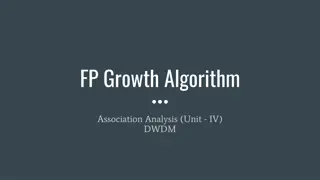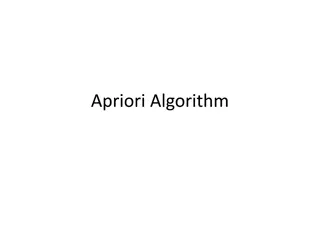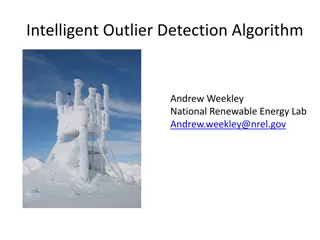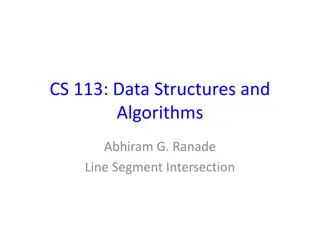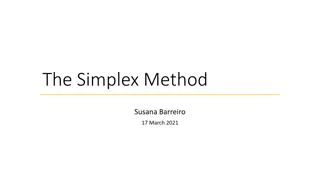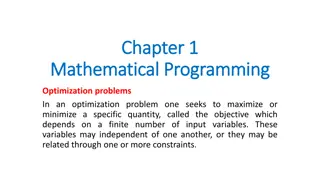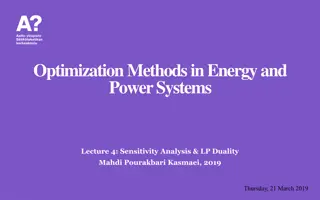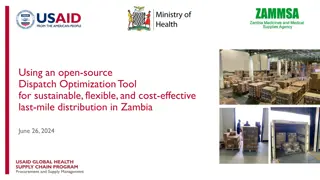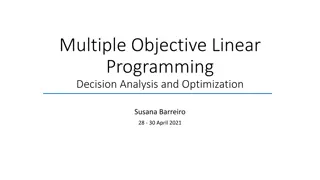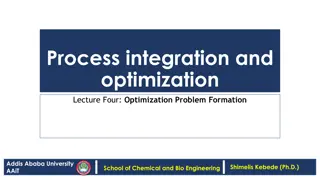Understanding Firefly Algorithm in Nature-Inspired Optimization
The Firefly Algorithm (FA) was developed by Xin-She Yang in 2007, inspired by fireflies' flashing behavior. It involves attractivity based on brightness, impacting optimization. By following set rules, fireflies move attractively towards brighter ones. Variations in light intensity and attractiveness play crucial roles in this algorithm, mimicking natural light absorption patterns.
Download Presentation

Please find below an Image/Link to download the presentation.
The content on the website is provided AS IS for your information and personal use only. It may not be sold, licensed, or shared on other websites without obtaining consent from the author. Download presentation by click this link. If you encounter any issues during the download, it is possible that the publisher has removed the file from their server.
E N D
Presentation Transcript
8 Firefly Algorithms Xin-She Yang, Nature-Inspired Optimization Algorithms, Elsevier, 2014.
8.1 The Firefly Algorithm FA was first developed by Xin-She Yang in late 2007 and published in 2008. FA was based on the flashing patterns and behavior of fireflies.
8.1.1 Firefly Behavior Two fundamental functions of such flashes Attract mating partners Attract potential prey Two combined factors make most fireflies visible to a limit distance The light intensity I decreases as the distance r increases in terms of I 1/r2. The air absorbs light, which becomes weaker and weaker as the distance increases.
8.1.2 Standard Firefly Algorithm Three idealized rules All fireflies are unisex One firefly will be attracted to other fireflies regardless of their sex. Attractiveness is proportional to a firefly s brightness. For any two flashing fireflies, the less brighter one will move toward the brighter one. The attractiveness is proportional to the brightness, both of which decrease as their distance increases. If there is no brighter one than a particular firefly, it will move randomly.
8.1.2 Standard Firefly Algorithm The brightness of a firefly is affected or determined by the landscape of the objective function.
8.1.3 Variations of Light Intensity and Attractiveness There are two important issues Variation of light intensity The brightness I of a firefly at a particular location x can be chosen as I(x) f(x) Formulation of the attractiveness The attractiveness is relative; it should be seen in the eyes of the beholder or judged by the other fireflies. Light attenuation Light absorption
The light intensity I (r ) varies according to the inverse square law where Isis the intensity at the source.
For a given medium with a fixed light absorption coefficient , the light intensity I varies with the distance r . That is, where I0is the original light intensity at zero distance r = 0
The combined effect of both the inverse- square law and absorption can be approximated as the following Gaussian form:
Because a fireflys attractiveness is proportional to the light intensity seen by adjacent fireflies, we can now define the attractiveness of a firefly by where 0 is the attractiveness at r = 0.
The distance between any two fireflies i and j at xi and xj , respectively, is the Cartesian distance where xi,k is the kth component of the spatial coordinate xi of i th firefly.
The movement of a firefly i attracted to another, more attractive (brighter) firefly j is determined by where the second term is due to the attraction. The third term is randomization, with being the randomization parameter, and iis a vector of random numbers drawn from a Gaussian distribution or uniform distribution.
8.1.4 Controlling Randomization A further improvement on the convergence of the algorithm is to vary the randomization parameter so that it decreases gradually as the optima are approaching or where (0, 1]
Simulations indicated that the efficiency may improve if we add an extra term i(g xi ) to the updating formula, where g is the current global optimum.
8.2.1 Scalings and Limiting Cases In fact, any measure that can effectively characterize the quantities of interest in the optimization problem can be used as the distance r . The initial locations of these n fireflies distribute relatively uniformly over the entire search space. As the iterations proceed, the fireflies would converge into all the local optima (including the global ones).
For 0, the attractiveness is constant = 0, FA Particle Swarm Optimization. For , the attractiveness is zero in the sight of other fireflies FA Simulated Annealing Because the firefly algorithm is usually a case between these two extremes, it is possible to adjust the parameter and so that it can outperform both simulated annealing and PSO.
A further advantage of FA is that different fireflies will work almost independently. It is thus particularly suitable for parallel implementation.
8.2.3 Special Cases of FA DE, APSO, SA, and HS are special cases of FA.
0= 0.5, = 1 and 0= 1 25 fireflies in 20 generations
8.4.1 FA Variants Discrete firefly algorithm (DFA) Chaotic firefly algorithm (CFA) Lagrangian firefly algorithm (LFA) Memetic firefly algorithm (MFA) Multiobjective discrete firefly algorithm (MDFA) Mulitobjective firefly algorithm (MOFA) Multi-objective enhanced firefly algorithm (MOEFA) Hybrid firefly algorithms (HFA) Parallel firefly algorithm with predation (pFAP)
8.5 Firefly Algorithms in Applications Digital image compression Highly nonlinear, multimodal design problems Antenna design optimization Discrete version of FA that can efficiently solve NP-hard scheduling problems Multi-objective load dispatch problems Classifications and clustering
Non-convex economic dispatch problem with valve-loading effect Economic load dispatch problems with reduced power losses Traveling salesman problem by discrete FA Scheduling jobs on grid computing Mixed integer programming and load dispatch problems
Training neural networks Isospectral spring-mass systems Support vector regression with the chaos- based FA for stock market price forecasting
8.6 Why the Firefly Algorithm is Efficient FA has two major advantages over other algorithms: Automatic subdivision Ability to deal with multimodality
First, FA is based on attraction and attractiveness. This leads to the fact that the whole population can automatically subdivide into subgroups, and each group can swarm around each mode or local optimum.
Second, this subdivision allows the fireflies to be able to find all optima simultaneously if the population size is sufficiently higher than the number of modes. This automatic subdivision ability makes FA particularly suitable for highly nonlinear, multimodal optimization problems.




